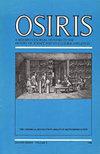工艺和代码二进制
IF 1
3区 哲学
Q2 HISTORY & PHILOSOPHY OF SCIENCE
引用次数: 0
摘要
本章阐述了工艺和代码之间的二元关系,使整个卷充满活力。这种二元性是在19世纪发展起来的(尽管可以更早地发现先例),当时它成为关于工厂理性、工业化和帝国的辩论中的一个重要元素。它随后被历史学家、哲学家和科学社会学家所采用,成为20世纪60年代至90年代出现的“科学研究”的关键组成部分。关于“学习”的争论与早期人工智能的工作交织在一起,因此工艺和代码的概念有助于构建算法文化本身的发展。随后的机器学习实践使这种关系更加复杂。人类/人工智能组合再也不能用可能适用于早期人类推理和机械算法概念的二进制来理解了。超越二进制不仅对理解当前的算法时代至关重要,而且对控制其进化也至关重要。本文章由计算机程序翻译,如有差异,请以英文原文为准。
The Craft and Code Binary
This chapter articulates the binary between craft and code that animates the volume as a whole. This binary was developed in the nineteenth century (although precedents can be identified much earlier), when it became an important element in debates about factory rationality, industrialization, and empire. It was subsequently adopted by historians, philosophers, and sociologists of science, becoming a key ingredient in the “science studies” that emerged in the 1960s–1990s. Debates about “learning” cross-fertilized with work in early artificial intelligence, such that notions of craft and code helped structure the development of algorithmic culture itself. Subsequent machine learning practices further complicated this relationship. Human/AI assemblages can no longer be comprehended in terms of a binary that may have been appropriate for earlier conceptions of human reasoning and mechanistic algorithms. Transcending that binary is critical not only for understanding the current algorithmic age but also for governing its evolution.
求助全文
通过发布文献求助,成功后即可免费获取论文全文。
去求助
来源期刊

Osiris
管理科学-科学史与科学哲学
CiteScore
1.10
自引率
0.00%
发文量
18
审稿时长
>12 weeks
期刊介绍:
Founded in 1936 by George Sarton, and relaunched by the History of Science Society in 1985, Osiris is an annual thematic journal that highlights research on significant themes in the history of science. Recent volumes have included Scientific Masculinities, History of Science and the Emotions, and Data Histories.
 求助内容:
求助内容: 应助结果提醒方式:
应助结果提醒方式:


